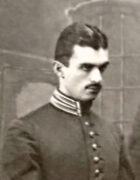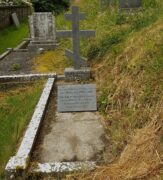Father Nicholas Couriss (full name Nikolai Ivanovich Couriss), a Russian nobleman of Greek ancestry, is one of the best-known White Russian emigrants to Ireland. After his arrival in Ireland in 1931, his house in the small town of Collon in Co. Louth became a center for the Russian émigré community and after the Second World War, a school for people willing to study the Russian language. In the last ten years of his life, Fr. Nicholas served as the only resident Orthodox priest on the island of Ireland. He is remembered with great respect to this day by Russian, Romanian and Greek émigrés, as well as by many Irish people.
The Couriss family were of relatively recent nobility. Their ancestor, a Greek settler named Couriss, had arrived on the territory of Lesser Russia back in the 17th century and moved to the Ukrainian city of Nezhin, where many Greeks had settled, unified around the Greek brotherhood of Nezhin.[1]V. A. Mikhal’chenko, O. G. Sivirin, Da budet pravda (Odessa: 2005), 9–10. It is not known how exactly the first Courisses earned a living; subsequently they were connected to the Ukrainian Cossacks. According to the recollections of people who knew him, Nicholas Couriss’s Greek blood could be seen in the somewhat dark color of his skin and his black hair in his youth.
Hereditary nobility was obtained by Ivan Onufrievich Couriss (c. 1762-1836) in 1793, when he acquired lands in southern New-Russia. He owed his career to Alexander Suvorov, one of the greatest military commanders in Russian history. A sabre belonging to Suvorov is kept in the Odessa Museum of the Arts given to the Odessa Society of History and Antiquity by the nephew I.O. Couriss.[2]V. Abramov, Ivan Iraklievich Couriss (1840–1898), Odessa Museum of the Arts: https://www.ofam.od.ua/pdf/article/abramov-kyris.pdf, 567. Papers preserved from Suvorov, stories about him and correspondence have served as valuable information for the biography of the great general. The descendants of Ivan Onufrievich would often choose a military career, and on taking retirement dedicate themselves to developing the estate. The life of the family was connected with Tavria, Odessa. Nicholas’s grandfather, Ivan Iraklievich Couriss (1841-1898), wrote his name into history as a patron of the arts, bibliophile, and art collector. It was he who remodelled the estate, turning it from a country house into Couriss Castle, situated in the village of Petrovka in the Odessa region, which is still well-known today.
Nicholas Couriss was the son of Ivan Ivanovich Couriss (1871-1938), a colonel in the Life Guards of His Imperial Majesty’s Regiment of Hussars and Elizabeth Nikolaevna Petrova, a daughter of lieutenant-general Nikolai Ivanovich Petrov, director of the police department. Nicholas Couriss was born on September 27 (October 10 according to the Gregorian calender), 1895 in Tsarskoye Selo.[3] CGIA SPb. F. 11. Op. 1. D. 3242. L. 3; NAI. 2013/50/243. Application for the certificate of naturalization. The wrong date is carved on the gravestone. In August 1915 he enrolled in the III (university) course at the Emperor Alexander Lycée. In contrast to others on the course, Nicholas did not board at the lycée. For some time he enjoyed permission to be a visiting student, and then changed to the status of an external student. From the Conference of the Emperor Alexander Lycée he received a letter of commendation “for attention to good morals, diligence, and excellent academic achievement.”[4]CGIA SPb. F. 11. Op. 1. D. 3242. L.15. He was an inquisitive young man. For instance, we know that he helped the naturalist and hunter Mikhail Alferaki (1889-1958) and provided him with materials on the Griffon vultures observed at the beginning of the 20th century in the environs of Odessa,[5]V.P. Belik, E.E. Shergalin, I.Zh. Frank’en, M.M. Alferaki, “Ptitsy Nizhnego Dona: Non-Passeriformes” (Birds of the lower Don: Non-Passeriformes), Strepet 10, No 1 (2012): 12. so he was observant and interested in nature. In his memoirs,[6]Gregory Porfirievich Tschebotarioff (1899-1985) was a Russian-born American civil engineer, a well-known specialist in soil mechanics and foundation engineering, author of books and scientific … Continue reading his childhood friend Gregory Tschebotarioff describes an episode during a long bike ride when they let the air out of the tires of their tutors bikes, “removed their hand-pumps to prevent pursuit, and sped off on our bicycles to see ‘Rússky Vityaz’” [7]G.P. Tschebotarioff, Russia, My Native Land (New York, London, Toronto: 1964), 22., an aeroplane that was widely regarded as a technological wonder of the early 20th century.
From June 1, 1916 he joined the fast-track officer courses of His Imperial Majesty Corps of Pages. In October 1918, he “escaped to Finland under a false name, dressed up as a fisherman. […] The Bolsheviki were searching for him and he had been forced to hide, never sleeping two nights running in the same place for many long weeks”[8]Memories of Mrs. Couriss “Days of Terror in Tsarskoe Selo,”1–2, 15/35/54, Box 79, University of Illinois Archives. He held the rank of warrant-officer of the Hussar regiment of Life Guards, fought in the Armed Forces of Southern Russia, and by 1919 had reached the rank of cornet; on June 26, 1919 he was sent from Tulcha to Novorossiysk on the ship “Violetta”; he was evacuated from Novorossiysk on the “Hannover” at the end of January 1920.[9]Database of S. Volkov, “Uchastniki Belogo dvizheniia v Rossii” (Members of the White movement in Russia), letter K, 1170, www.swolkov.org
To start with, Nicholas Couriss, like thousands of other Russian émigrés, found himself in Constantinople. In summer 1920, he met his childhood friend Gregory Tschebotarioff there: “Soon after my arrival I ran into my old Tsárskoye Seló friend Nika Coúriss who had rented an old dilapidated house, which was abandoned because it was uninhabitable in winter. In the summer it was quite nice, however, since it was located at the top of a hill overlooking the Bosporus… with a beautiful view from its windows”[10]Tschebotarioff G.P. Ibid., 279. From his mother’s recollections, thanks to his knowledge of English, Nicholas served in the American Red Cross in Constantinople.[11]University of Illinois Archives. Ibid., 21. Then he moved to Greece. Probably his family ties with Greek societies came in useful. In Greece, he served as secretary in the British consulate in Saloniki. His wife Ksenia Nikolaevna Bibikova (or Ksana, as she called herself), was born on November 21, 1894 in Warsaw. She was the daughter of the cavalry general Nikolai Valerianovich Bibikov, the governor of Warsaw, and Anna Evgen’evna von Rosenschild-Paulin. Ksenia had been a lady in waiting to their Imperial Majesties, and in 1914-1917 a nurse in the military hospital in Petrograd.[12]G. Rovenskii, N. Bibikov, Rodoslovnaia Bibikovykh. K 700-letiiu dvorianskogo roda Bibikovykh (The genealogy of the Bibikovs. On the 700th anniversary of the Bibikov dynasty), (Friazino: 1996), 80. Acquaintances of Nicholas Couriss recount a romantic story of how they met before the Russian Revolution of 1917: “in the winter the great families of Russia would give receptions at their houses, and the officers of the Guard would be invited and there he fell in love with a daughter of the house. But it was a hopeless love. Her family was among the greatest in Russia and owned half the Ukraine. They had played a big part in Russian history… In Constantinople he met the woman to whom as a young guardsman he had lost his heart” [13]P. Shanley, “The Story told by a Russian Priest,” Cathair Na Mart. Journal of the Westport Historical Society 17 (1997): 154. The wedding took place on June 3, 1923 in Baden Baden. Two years later, on September 25, 1925, their son Ilya was born in Saloniki.
In 1931, the family received permission to move to Ireland in order for Couriss to run a poultry farm in the town of Collon in County Louth. In all probability, Couriss had made friends with one of the Irish representatives of the charitable organizations for refugees, and help had been promised to him in Ireland. Shortly after their move, tragedy struck the Couriss family. Their only child Ilya died on September 24, 1934 at the age of eight from heart failure and acute polio.
After their arrival the Couriss household became a center of the Russian community in Ireland. At the same time, Countess Martha Apraxine (1913-1968), the daughter of Count Peter Apraxine (1876-1962) and Elisabeth Bariatinsky (1882-1948), arrived in Ireland, where she studied at the National University and was qualified as a Medical Doctor. Prince Paul Lieven (1875-1963) also lived there; his youngest son Alexander (1919-1988) studied at Trinity College Dublin, the only Russian at the university, till the end of the 1930s.[14]D. Lieven, “Princess Lieven: a Family History,” Russkoe nasledie v sovremennom mire. Russkie v Velikobritanii i britantsy v Rossii. Chetvertaia mezhdunarodnaia nauchno-prakticheskaia … Continue reading Prince Paul was a distant relative of Ksana Couriss, and she called him uncle. Later he moved to London, but continued to make regular visits to the house in Collon. He helped with the pupils at the Couriss’s language school, kept up discussions and the atmosphere of a Russian home. In 1951, a friend from the Lycée Michael Tolstoy (1896-1980) moved to Collon with his wife Miriam (1906-1971).[15]For more detail on Michael Tolstoy, see: M.P. Golenishchev-Kutuzov-Tolstoy, Istoriia moei zhizni, trans. from English and comm. A.S. Bykova, M.G. Talalay (Moscow: 2020). He had decided to follow the example of his Lycée classmate and build a life in far-off Ireland.
Apart from the poultry farm, Nicholas Couriss grew mushrooms to sell, which was a new thing in Ireland, he grew and sold flowers, vegetables, fruit. They lived simple lives. When Couriss’s application for Irish citizenship was processed, the authorities were concerned that his poor financial situation would not enable him to pay the usual fee; nonetheless citizenship was granted, taking into account his noble origin and stateless status. Nicholas Couriss received certificate No. 67, dated August 27, 1937. His wife Ksana was to obtain citizenship much later in 1948.
After the Second World War, the Couriss’s financial situation improved, as they found a new source of income: they opened a Russian language school for British and Irish officers, diplomats and university graduates. The school with residency was opened in their own home at the address: The Old Courthouse, Collon, County Louth.
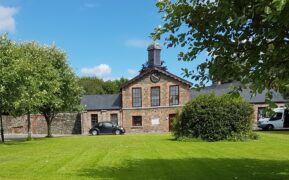
The Old Courthouse, Collon, County Louth, 2017 (photograph А. Bykova)
There are rumours in Ireland that three of the “Cambridge Five” – Kim Philby, Guy Burgess, and Donald Maclean – studied Russian in Collon.[16]P. Comerford, A tiny corner of Cambridge, and Lichfield, and Russia, in Collon, Co. Louth, Wednesday, August 31, 2011: http://www.patrickcomerford.com/2011_08_31_archive.html It has not been possible to verify this information. However, we know that another well-known double agent, George Blake, studied Russian at the school in Collon. In his memoirs No Other Choice, he reports that he spent three weeks in the school:
I […] left Cambridge at once after the exams […] to spend three weeks […] in the house of Russian émigrés who lived in a small village not far from Dublin. In those days there were no exchange programmes for language students. If one wanted to get practice in speaking one had to go and live for a while with a family of Russian émigrés, either in England or abroad. Our host was a prince who made a living by growing mushrooms, which he sold to Dublin restaurants, and by having Russian language students staying at his house. His wife was a tall, stately woman, the daughter of the last Russian viceroy of Poland, who tried against all odds to maintain an air of bygone splendour. This was not easy in her modest circumstances. Nothing could conceal, for instance, that her drawing-room sofas were made of vegetable crates covered with chintz. I found this spirit admirable. While we were there an old Cossack general with thick, grey whiskers called on our hosts and crossed himself before the icons in the corner as he came into the room. This impressed us much and we imagined we were somewhere in old Russia.
We had to speak Russian during all the meals and whenever we were with the family. This was, at first, very tiring, but gradually became easier. The main benefit of our stay, apart from the long walks in the beautiful Irish countryside, was that we acquired a certain assurance from the fact that people actually understood our spoken Russian and that we got the hang of most of what they were saying.[17]G. Blake, No Other Choice: An Autobiography, Jonathan Cape, 1990, p. 109.
The Couriss school had a good reputation and was popular; Ksana Couriss was remembered as a very gifted teacher, and the teaching methods in Collon were called “the most enjoyable system of learning Russian in existence. As guests in a Russian-speaking household which combines the most attractive features of both the Irish and the Russian ways of life, students acquire a great deal more of this difficult and absorbing language in a few weeks, with considerably less hardship, than would be possible over several terms of mere deskwork.”[18]“An Irishman’s Diary,” The Irish Times (February 17, 1959). The Courisses themselves were very competent teachers, but did not have any academic qualifications or institutional status, and so were not able to award diplomas. Exams were taken in Great Britain.[19]For more detail on Russian language schools in Ireland in the 1940-1960s, see: A.S. Bykova, “Zhiteli Britanskikh ostrovov – ucheniki russkikh emigrantov ‘pervoi volny’ v Irlandii” … Continue reading
There was great demand for Russian lessons, and the Courisses began to hold classes in Dublin. They recruited a class of beginners and offered individual tuition at a higher cost than in Collon. Here is an advertisement in the Irish Times from 1959:
RUSSIAN TUITION, all levels by native-speaking bilingual couple. Special training, university honours courses and civil service examinations. Afternoon and evenings. Dublin. Apply Couriss, Collon, Co. Louth.
Among the Courisses’ students, were Conor Cruise O’Brien, Máire MacEntee, Eoin MacWhite, and Edward Brennan, the officers of the Irish Department of External Affairs. In 1974, Brennan became the first ambassador of Ireland to the USSR. Another well-known student was the army officer Martin Bates, who in 1957 started lectures and Russian classes at UCD.
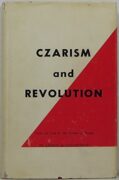 The 1960s were a very active time for Nicholas Couriss. Apart from the work with his students, he translated two books into English: A. Goulevitch Czarism and Revolution (Hawthorne, California, 1962); and the memoirs of Count K.K. Pahlen, Mission to Turkestan: Being the Memoirs of Count K. K. Pahlen, 1908–1909 (London, New York, Toronto, 1964). With these works Couriss hoped to demolish established stereotypes of Russia and her history in Western society and, as he wrote himself in the preface, wanted to show “another” Russia, “in which the monarchy, democratic in origin and Russian in essence, shared in every manifestation of the nation’s life; how it was identified with the political, economic and spiritual development of the nation and how it pointed the way to progress and enlightenment.[20]A. Goulevitch, Czarism and Revolution, trans. from the French by N. J. Couriss (Hawthorne, California: 1962), 8. Nicholas Couriss was a staunch opponent of Soviet communism and a supporter of the ROCOR.
The 1960s were a very active time for Nicholas Couriss. Apart from the work with his students, he translated two books into English: A. Goulevitch Czarism and Revolution (Hawthorne, California, 1962); and the memoirs of Count K.K. Pahlen, Mission to Turkestan: Being the Memoirs of Count K. K. Pahlen, 1908–1909 (London, New York, Toronto, 1964). With these works Couriss hoped to demolish established stereotypes of Russia and her history in Western society and, as he wrote himself in the preface, wanted to show “another” Russia, “in which the monarchy, democratic in origin and Russian in essence, shared in every manifestation of the nation’s life; how it was identified with the political, economic and spiritual development of the nation and how it pointed the way to progress and enlightenment.[20]A. Goulevitch, Czarism and Revolution, trans. from the French by N. J. Couriss (Hawthorne, California: 1962), 8. Nicholas Couriss was a staunch opponent of Soviet communism and a supporter of the ROCOR.
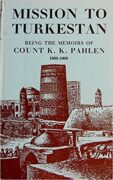 Ksana Couriss died on July 28, 1966. For the last four years of her life, she suffered from Parkinson’s disease. Nicholas took her passing with difficulty; he was already 70 and had severe arthritis. Then he left to study theology in the USA. There is a beautiful story connected with his time in America that Father Nicholas subsequently told people who knew him: “he suddenly became very ill. The doctor was called and said to him, ‘Nick, you have faced death many times in the wars, and therefore, I can tell you the truth without any cover-up. You have incurable cancer and you will die in about three months.’ Fr Nicholas replied, ‘All the money I have in the world is one dollar in my pocket, and I am prepared to bet you that I do not have cancer.’
Ksana Couriss died on July 28, 1966. For the last four years of her life, she suffered from Parkinson’s disease. Nicholas took her passing with difficulty; he was already 70 and had severe arthritis. Then he left to study theology in the USA. There is a beautiful story connected with his time in America that Father Nicholas subsequently told people who knew him: “he suddenly became very ill. The doctor was called and said to him, ‘Nick, you have faced death many times in the wars, and therefore, I can tell you the truth without any cover-up. You have incurable cancer and you will die in about three months.’ Fr Nicholas replied, ‘All the money I have in the world is one dollar in my pocket, and I am prepared to bet you that I do not have cancer.’
There is a rather beautiful little church in Washington called the Church of the Blue Virgin, because there is a famous stained glass window there showing the Virgin dressed in blue. Fr Nicholas went there and prayed earnestly because his position was very worrying. If he had cancer, as the doctor said, he could not continue at the seminary and what was to become of him now. As he saw it, he could not just be idle and wanted to engage in useful work. That night he suffered terribly but in the morning he was well”. [21]Shanley P. Ibid. P. 155. On January 14, 1967, Metropolitan Philaret of the Russian Orthodox Church Outside of Russia ordained him to the priesthood,[22]N. Evseev, priest, “In Memory of Father Nicholas Couriss,” 2011, http://www.rocorstudies.org/2011/12/30/in-memory-of-father-nicholas-couriss/ after which Fr. Couriss returned to Ireland. In April 1967, for the first time the Dublin Orthodox community celebrated the Easter service with its own priest. The services took place in St. Phillip’s Church on Temple Road.
Father Nicholas’s younger sister Luba also came to Dublin to look after him. Father Nicholas Couriss became the first resident Russian Orthodox priest in Ireland. The Russian congregation in Dublin was small and entirely made up of elderly White émigrés. He also celebrated services for members of the Greek Orthodox Church, a fact which is still remembered in Ireland. There were also some Irish people and representatives of other nationalities, literally just a few people. In 1969, he moved from Collon to Dublin, where he lived at 45 Pembroke Lane, Dublin 4. There he set up a small chapel on the second floor. One of Father Couriss’s parishioners recalls: “The main room on the top floor was converted into a chapel, and some 18 people regularly attended the Divine Service there on a weekly basis, until he became so feeble the service was held every second week. Yet he regularly visited the sick — who were mainly Greeks — as he was the only Orthodox priest in Ireland.”[23]R. Mac Eoghain, “Memories of Father Nicholas, 1999,” Orthodox Ireland, http://web.archive.org/web/20030728112349/www.orthodoxireland.com/history/frnicholascouris/view.
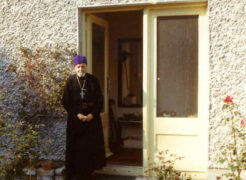
Father Nicholas Couriss, a Dublin parishioner who was ordained to the priesthood in 1967 and served the Dublin parish until he died in 1977. (Photo by Nicolas Mabin. 1972 )
Father Couriss and his sister lived modestly; the parish was very poor. The house belonged to Countess Martha Apraxine. After her death in 1968, it was inherited by her sister Nadine Makaroff (1911-2002), who lived in Brussels; she made the house available for use by Father Nicholas Couriss and his sister free of charge. In his obituary, published in The Living Church, it was especially emphasized that “His own home became a center for the Greek Orthodox as well as the Russian Orthodox.”[24]“Only Russian Priest in Ireland Dies,” The Living Church (October 2, 1977). His neighbors remember to this day how around the 1960s Father Nicholas wedded a Greek couple there, and that they celebrated, and danced on the street in colorful outfits.
The Orthodox community did not have its own church; services took place in premises belonging to other churches: for example, in the Seamen’s Mission in Quays, Trinity College, and also in nursing homes for elderly Russian refugees: St. Andrew’s Red Cross Home (specially created for elderly European refugees from China, most of whom were White émigrés), and The Haven (a home for European refugees after the Second World War). In the last years of his life, Fr. Couriss often visited the house of the brothers Rory and Colin Peck, “Prehen,” in Derry, Ireland, where they built a small chapel for him.
Father Nicholas Couriss died on August 16, 1977 at the age of 81. He was buried in the cemetery of Collon next to his wife and
son. According to the recollections of his parishioners and neighbours: “One Palm Sunday […] Father Nicholas went into the back garden to collect the palms for the service. It was snowing very heavily, and he fell and broke his hip. He lay down, unable to move, for about an hour, until his sister, concerned about his absence, went out and found him. He was immediately hospitalised in St Vincent’s Hospital in Dublin, and following operation was transferred to a nursing home. Archbishop John (Shakhovskoy) of San Francisco (of the OCA) happened to be in Dublin en route to a conference in Sweden, and being a former student with Father Nicholas in Russia, he called to Father Nicholas’s home. Learning of his accident, the Archbishop visited him in the nursing home.”[25] Mac Eoghain R. Ibid. Two days later Fr. Nicholas died. His funeral in Collon was attended by many friends, the Archbishop of Armagh and Primate of all Ireland, dr. Simms, some monks from the nearby abbey of Mellifont and other priests. The funeral service was conducted by Father Ioann Syshchenko from London. Luba Couriss returned to the USA and soon followed her brother. She died on January 7, 1979 in the small town of Orange, California.
After many years of neglect, the chapel of the Kazan Icon of the Mother of God in Prehen is once again used by the Orthodox community of Northern Ireland. The graves of Father Nicholas and his family are not forgotten; they are visited regularly, and memorial services are served there.
References
| ↵1 | V. A. Mikhal’chenko, O. G. Sivirin, Da budet pravda (Odessa: 2005), 9–10. |
|---|---|
| ↵2 | V. Abramov, Ivan Iraklievich Couriss (1840–1898), Odessa Museum of the Arts: https://www.ofam.od.ua/pdf/article/abramov-kyris.pdf, 567. |
| ↵3 | CGIA SPb. F. 11. Op. 1. D. 3242. L. 3; NAI. 2013/50/243. Application for the certificate of naturalization. The wrong date is carved on the gravestone. |
| ↵4 | CGIA SPb. F. 11. Op. 1. D. 3242. L.15. |
| ↵5 | V.P. Belik, E.E. Shergalin, I.Zh. Frank’en, M.M. Alferaki, “Ptitsy Nizhnego Dona: Non-Passeriformes” (Birds of the lower Don: Non-Passeriformes), Strepet 10, No 1 (2012): 12. |
| ↵6 | Gregory Porfirievich Tschebotarioff (1899-1985) was a Russian-born American civil engineer, a well-known specialist in soil mechanics and foundation engineering, author of books and scientific articles in his field. |
| ↵7 | G.P. Tschebotarioff, Russia, My Native Land (New York, London, Toronto: 1964), 22. |
| ↵8 | Memories of Mrs. Couriss “Days of Terror in Tsarskoe Selo,”1–2, 15/35/54, Box 79, University of Illinois Archives. |
| ↵9 | Database of S. Volkov, “Uchastniki Belogo dvizheniia v Rossii” (Members of the White movement in Russia), letter K, 1170, www.swolkov.org |
| ↵10 | Tschebotarioff G.P. Ibid., 279. |
| ↵11 | University of Illinois Archives. Ibid., 21. |
| ↵12 | G. Rovenskii, N. Bibikov, Rodoslovnaia Bibikovykh. K 700-letiiu dvorianskogo roda Bibikovykh (The genealogy of the Bibikovs. On the 700th anniversary of the Bibikov dynasty), (Friazino: 1996), 80. |
| ↵13 | P. Shanley, “The Story told by a Russian Priest,” Cathair Na Mart. Journal of the Westport Historical Society 17 (1997): 154. |
| ↵14 | D. Lieven, “Princess Lieven: a Family History,” Russkoe nasledie v sovremennom mire. Russkie v Velikobritanii i britantsy v Rossii. Chetvertaia mezhdunarodnaia nauchno-prakticheskaia konferentsiia (Russian heritage in the modern world. Russians in Great Britain and Britons in Russia. Fourth international academic-practical conference). A Collection of academic articles (London: 2018), 40. |
| ↵15 | For more detail on Michael Tolstoy, see: M.P. Golenishchev-Kutuzov-Tolstoy, Istoriia moei zhizni, trans. from English and comm. A.S. Bykova, M.G. Talalay (Moscow: 2020). |
| ↵16 | P. Comerford, A tiny corner of Cambridge, and Lichfield, and Russia, in Collon, Co. Louth, Wednesday, August 31, 2011: http://www.patrickcomerford.com/2011_08_31_archive.html |
| ↵17 | G. Blake, No Other Choice: An Autobiography, Jonathan Cape, 1990, p. 109. |
| ↵18 | “An Irishman’s Diary,” The Irish Times (February 17, 1959). |
| ↵19 | For more detail on Russian language schools in Ireland in the 1940-1960s, see: A.S. Bykova, “Zhiteli Britanskikh ostrovov – ucheniki russkikh emigrantov ‘pervoi volny’ v Irlandii” (Inhabitants of the British isles – students of the Russian émigrés of the ‘first wave’ in Ireland), Russkoe nasledie v sovremennom mire: Vtoraia mezhdunarodnaia nauchno-prakticheskaia konferentsiia. (Russian heritage in the modern world: second international academic-practical conference) Collection of academic materials Great Britain, London: June 27 2017 (Committee for “Russian heritage in the United Kingdom of Great Britain and Northern Ireland,” London: 2017), 10–24. |
| ↵20 | A. Goulevitch, Czarism and Revolution, trans. from the French by N. J. Couriss (Hawthorne, California: 1962), 8. |
| ↵21 | Shanley P. Ibid. P. 155. |
| ↵22 | N. Evseev, priest, “In Memory of Father Nicholas Couriss,” 2011, http://www.rocorstudies.org/2011/12/30/in-memory-of-father-nicholas-couriss/ |
| ↵23 | R. Mac Eoghain, “Memories of Father Nicholas, 1999,” Orthodox Ireland, http://web.archive.org/web/20030728112349/www.orthodoxireland.com/history/frnicholascouris/view. |
| ↵24 | “Only Russian Priest in Ireland Dies,” The Living Church (October 2, 1977). |
| ↵25 | Mac Eoghain R. Ibid. |


